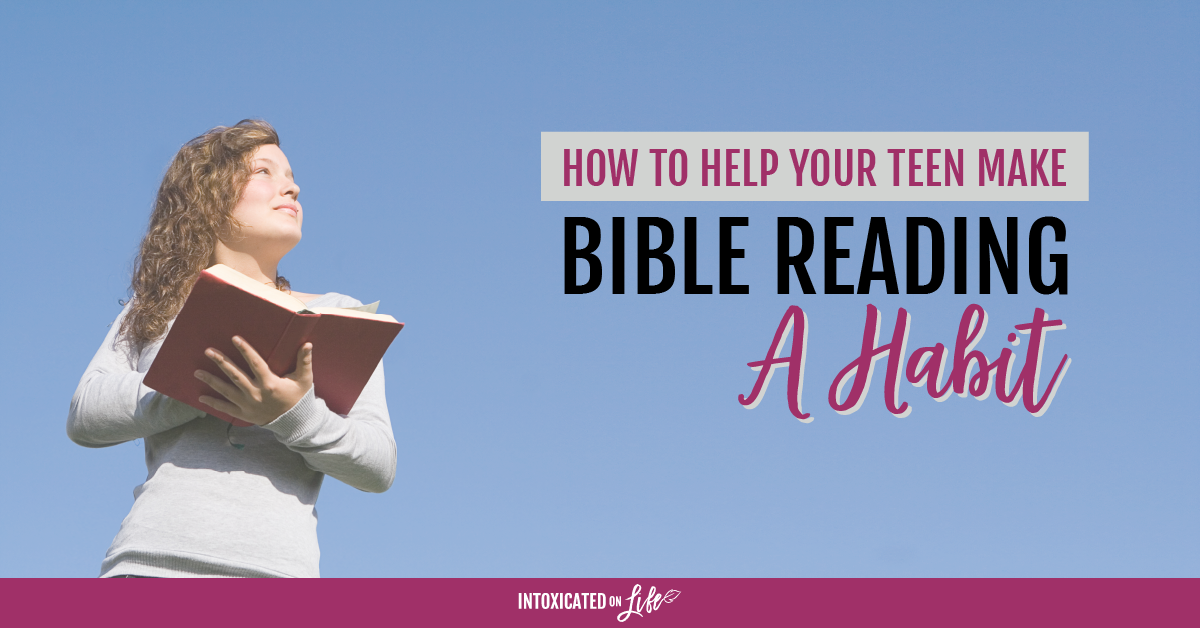If there was just one habit you could help your teen foster before they graduate high school, what would it be?
I could think of several obvious ones at the top of my list: good hygiene habits, sticking to an exercise schedule, waking up on time, etc.
But what about spiritual habits? What about making Bible reading a habit?

Before I dive into this, it’s probably important to say that there can be a lot of false guilt around this topic. I grew up in an era where having your “quiet time” was the metric by which the quality of your Christianity rose or fell.
I don’t for a minute think that’s true.
Most Christians lived in an era where “personal Bible reading” wasn’t even a possibility—personal Bibles weren’t really a thing until the last few hundred years of history.
Still, the habit of daily Bible reading isn’t something we do because we have to. We do it because we get to — it’s a privilege.
How to Make Bible Reading a Habit: 8 Considerations to Help Teens
1. Supply the right motivation: teach your teen the real value of the habit of Bible reading
Kids (and adults) raised in Christian homes can become desensitized to the idea of the Bible as the “Word of God.” But pondering this idea for just a few moments should make us stand in awe of the Scriptures and the power they hold.
Why make Bible reading a habit? Because it is a “God breathed” library—filled with many genres of literature but with one inspired story pointing to Jesus. We are promised that by knowing the Scriptures…
- We get to know the living God intimately and are transformed by knowing him (2 Corinthians 3:12-18).
- We are promised we will be equipped for every good work we need to do in life (2 Timothy 3:15-17).
- Our true motives are exposed to us—we know ourselves better (Hebrews 4:12).
- We grow in hope (Romans 15:4).
- We grow wise through the stories of God’s actions in the past (1 Corinthians 10:11).
- We are purified and made holy (John 17:17; Ephesians 5:26).
- Our souls are revived and we grow in joy (Psalm 19:7-11).
By supplying our teens with the promises found in the Bible about the power of Scripture, they are given a proper motive to keep this habit going.
2. Anchor the habit: read the Bible before or after something another habit
Dr. BJ Fogg, author of Tiny Habits, says one of the best ways to start a new habit is to “anchor” it to an old one.
What’s something you already do without thinking much about it—a solid routine you already do? Wake up at a certain time? Brush your teeth? Take a shower? Sit at your desk? Pour a cup of coffee? Anything can be an anchor as long as it’s something you already do every day (or nearly every day).
Ask your teen to anchor Bible reading habit to something else: “After I _________, I will open my Bible.” This will help the habit to stick.
3. Build margin: talk about eliminating the “too busy” excuse.
The Center for Bible Engagement found, unsurprisingly, that the most common reason given for not reading or listening to the Bible regularly is that the respondent is “too busy.”
Many times “too busy” is really just misplaced priorities—too much attention is given to other things.
The best way to guard against this is to build margin into your teens’ life. Talk beforehand about the timing of the “anchor” (see step 2 above) so it doesn’t feel like a rushed activity. When both you and your teen are on the same page about this planned time for Bible reading, it can be a little “sacred time” carved out for him or her.
4. Pick a spot: find an non-distracting location
Have your teen pick a familiar spot, free of distractions. Distracting locations can easily sabotage your teen’s focus. Silence all alerts and notifications, and get into a quiet space.
5. Get some helpful tools: a good study Bible and a journal
Two surefire ways for teens (or even adults) to lose steam reading the Bible are: (1) lack of understanding, and (2) lack of reflection. When we don’t understand what we’re reading, or we don’t take time to reflect on the significance of what we’re reading, it’s easy to let our eye glaze over as we move from one word to another.
Two good tools can help us avoid this: a good study Bible and a writing journal.
A study Bible can be helpful because often the footnotes are designed as brief remarks to help the reader understand the context of the passage, the flow of the passage, or clarify confusing expressions. It’s one thing to lug out 5 dense commentaries when doing a deep-dive Bible study. But when you’re just reading for breadth, a study Bible is the way to go. (Some of my favorites are ESV Study Bible, The Reformation Study Bible, and the Archaeology Study Bible.)
A writing journal can also be a big help for active reading of the text. This doesn’t have to be complicated. It could be as simple as…
- brief notes about what they read
- questions about the text
- observations
- anything that stood out to them to remember
- prayers to God, prompted by the text
If you want to get creative, you could even invest in some “Scripture Journals”—the left-hand pages contain the text of Scripture; the right-hand pages are blank for writing notes. (Every book of the Old and New Testament can be purchased in sets or as individual books.)
6. Read whole books: take in whole books of the Bible (or at least large portions) in one sitting
There’s a great value to reading whole books of the Bible in one sitting, or at least reading large portions.
Remember: the chapter and verse numbers in the Bible are not divinely inspired. They weren’t added until the 16th century as helpful reference points.
Think of the way you read a letter or email from a friend: you read the whole thing from beginning to end. Do the same with the letters of the New Testament.
Think of how you read a novel: you read large portions in one sitting, getting through whole episodes before you put the book down. Do the same with the long narratives of the Bible.
Doing this helps you keep track of the narrative and plot lines, allows you to see how characters are developed, and allows you to see themes more easily.
Here are all the books of the New Testament, listed from shortest to longest and an estimated amount of time to read each one.
3 John – 219 words, 2.2 minutes
2 John – 245 words, 2.5 minutes
Philemon – 335 words, 3.5 minutes
Jude – 461 words, 4.6 minutes
Titus – 659 words, 7 minutes
2 Thessalonians – 823 words, 8 minutes
2 Peter – 1,099 words, 10 minutes
2 Timothy – 1,238 words, 12 minutes
1 Thessalonians – 1,481 words, 15 minutes
Colossians – 1,582 words, 16 minutes
1 Timothy – 1,591 words, 16 minutes
Philippians – 1,629 words, 16 minutes
1 Peter – 1,684 words, 17 minutes
James – 1,742 words, 17.5 minutes
1 John – 2,141 words, 21 minutes
Galatians – 2,230 words, 22 minutes
Ephesians – 2,422 words, 24 minutes
2 Corinthians- 4,477 words, 45 minutes
1 Corinthians – 6,830 words, 68 minutes
Romans – 7,111 words, 1 hour 11 minutes
Revelation – 9,851 words, 1 hour 38 minutes
Mark – 11,304 words, 1 hour 53 minutes
John – 15,635 words, 2 hours 36 minutes
Matthew – 18,346 words, 3 hours 3 minutes
Acts – 18,450 words, 3 hours 4 minutes
Luke – 19,482 words, 3 hours 14 minutes
As you can see, over half of the books of the New Testament can be read in less than 20 minutes. For the books taking longer than 20 minutes, you might challenge your teen to read those in 10- to 20-minute chunks.
Remember: the goal is starting a simple habit. Ambitious teens might want to bite off more than they can chew longterm—so tell them to keep is simple at first: 20 or 30 minutes to read, reflect, and pray.
7. Work from a checklist: follow a plan and keep track of what is read
Teach your teen to resist the urge to just jump around at random. The goal is establishing a longterm habit so they can absorb “the whole counsel of God” (Acts 20:27) throughout their lives.
The easiest thing to do is to work from a Bible reading plan. There are many of these to choose from.
There’s something very satisfying about checking things off a list: it allows your teen to see their progress and celebrate the new habit.
8. Consider an immersive course: pair Bible reading with a good survey course
Does your teen know how to study the Bible? Many parents have never considered enrolling their teen in a Bible survey course, but it can be just the thing to establish both a good Bible-reading habit and a depth of Bible understanding.
The Bible is not just a book: it’s a library. More than this, it is a library of ancient literature—and as such, teens (and adults) often need help reading it.
Think if you were reading the works of Dante or Shakespeare. You would never approach their books with a narcissistic attitude of, “What does this mean to me?” You would know, intuitively, that you would benefit from the scholars and experts in their literature navigating them the way the authors intended them to be read.
The Bible is no different. Yes, it’s inspired by God, but it’s inspired using human words and writing styles.
This is where a Bible survey class can be so valuable for a teenager.
- It helps them read the Bible as literature.
- It helps them understand the Bible in its historical context.
- It gives them built-in accountability and reading assignments.
- They come away with understanding how to approach reading the Bible for the rest of their lives.
Here are some questions you should consider when choosing a Bible course for your teen.
Teen Bible Reading: Take the Challenge!
So those are my 8 considerations for helping your teen making Bible reading a habit:
- Supply the right motivation
- Anchor the habit
- Build margin
- Pick a spot
- Get some helpful tools
- Read whole books
- Work from a checklist
- Consider an immersive course
If you’d like help with that last one, I’m excited to announce the launch of our new full school year online course for high schoolers: Equipped: Tools for Exploring the Bible. Our new course is designed just for teens and will give them the tools, techniques, and context for exploring the Christian faith not as children, but as young adults.












These are great ideas! I didn’t realize how much could really be read in 20 minutes. Thanks for that breakdown 😊